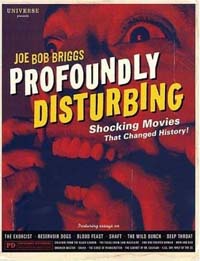
Profoundly Disturbing was Joe Bob Briggs’ take on 15 films that changed modern cinema. Was? The book appeared in 2003. I bought it for my friend Doc as a gift then because he’s a Joe Bob fan. Recently, I stumbled upon it in the discount bin at Book People and scored it since what little I read of Doc’s copy was interesting. It’s an ambitious project for an author who is more famous for his expertise on the B-Movies he MC’d for The Movie Channel and TNT. Besides, this is a topic already covered to death by the “established, well-respected” film critics. I would immediately agree with that sentiment if Joe Bob weren’t so funny, insightful and well-versed in the history of film. Roger Ebert should’ve hired him to replace Gene Siskel.
I think my book review’s timing worked out pretty well too. Grindhouse opens this weekend and the Rodriguez-Tarantino homage is a movie right up Joe Bob’s alley. Sadly, there’s no sign of Joe Bob reviewing it on his site…yet.
As a book, Profoundly is great and hard to put down. If I taught a class on the history of film, I would put this on the syllabus as recommended reading. For those not so obsessed over movies, it’s still a compelling series of 15 essays. He starts with 1919’s The Cabinet of Dr. Caligari and end’s with 1996’s Crash (Cronenberg’s movie, not the recent Oscar winner). Going with a chronological approach was a smart decision, it allowed him to present each movie in its historical context (where Joe Bob really shines) and how some pushed the standards enough for the next one to be made. For example, I was a little kid when Deep Throat was released. Despite learning about all the court decisions on the indecency standards that led to its wider distribution in college, I still never understood what was this flick’s appeal or even why Porn was chic in the Seventies until Joe Bob elaborated. His answer may not be the complete one, but it’s a strong start and an adequate answer until I find other books.
Besides, the societal conditions of these movies’ release, he tells the details about how most were made, what the critics said, whatever happened to those involved afterwards, etc. All end with a section referencing movies that this particular one may have been derived from, others that were similar at the time and the ones it may have influenced. For example, Shaft is usually thought of as the first Blaxploitation film but it had been preceded by Cotton Comes to Harlem and Watermelon Man. Which movies followed is rather obvious but more importantly, it paved the way for Black action heroes such as Wesley Snipes, Samuel L. Jackson, Will Smith, Eddie Murphy and Halle Berry.
I disagree on his choices of Mom and Dad and Drunken Master as being “disturbing” movies. The former was really an old con game to sell books with medicine-show tactics and stock footage. Stirring up controversy was how its main creator Kroger Babb filled up the theater. I don’t think Mom and Dad has any lasting legacy unless you count George Lucas’ ability to push action figures. As for Drunken Master, it’s more about how Jackie Chan stepped out of the shadow of Bruce Lee by making comical martial arts movies instead of more remakes of Enter the Dragon. There were no armies of protesters boycotting his films. Despite my nitpicking on those two essays, their content is solid and entertaining even if they “failed” to support the book’s argument.
He is dead on with the remaining 13 on how they shocked audiences using gore, amoral heroes, extremely graphic violence, detached and emotionless sex, torture and odd casting choices. It wouldn’t be a Joe Bob book if the majority didn’t involve blood and guts, six are Horror flicks and four are known for their violence. He also does an excellent job of writing without sounding like a snob or someone who’s only into the “irony” of the B-Movies. It’s genuine, enthusiastic and humorous without pulling any punches on the quotes from the people involved or their sordid backgrounds, especially Linda Lovelace.
Again, I wholeheartedly endorse this book whether you’re a film buff (my friends Jose, Rad, Steve and Doc) or you want to read something casual that entertains and informs. Meanwhile, I will start looking for a copy of his sequel Profoundly Erotic which covers movies with key love scenes that changed history. I can immediately tell you it’s not a collection of porn or the R-rated teen-sex romps since he writes about It Happened One Night and Belle de Jour.

I’m curious: what are the 15 films? You mention six and I’d be interested in what the others were. Tell me “The Wild Bunch” is one of them! Graphic violence aside, the multi-camera, quick-cut editing style was (I believe) pretty darn revolutionary at the time.